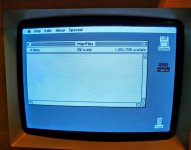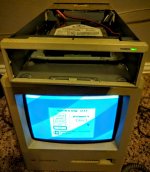mrcity
Experienced Member
I decided I was about through with swapping disks 25 times while trying to load Photoshop 1.0.7, not to mention having to swap disks just to do other things like change settings or make a gradient.  Sure it gives an authentic 1980s experience, but you only need to live it once! Here's my brief success story on adding a 3rd-party SCSI drive to a Mac Plus.
Sure it gives an authentic 1980s experience, but you only need to live it once! Here's my brief success story on adding a 3rd-party SCSI drive to a Mac Plus.
Having an eye for stuff I could use (in existing projects, mind you ) I scored an IBM-branded 8x external SCSI CD-ROM drive and five SCSI drives (3x SCSI-2 and 2x SCSI-3) from "Fred's Warehouse Of Wonder" (which sadly the scrapper finally tore through last month). I ripped out the old CD-ROM drive and replaced it with one of the SCSI-2 drives since that's what the guts supported. Turns out this was the trickiest part of the whole affair -- them internal cables be short! I matched the drive's jumper settings for SCSI ID with that of the enclosure (incidentally I set it to ID 6 since the Mac enumerates from highest first), hooked it all up, and powered it on with the system disk inserted.
) I scored an IBM-branded 8x external SCSI CD-ROM drive and five SCSI drives (3x SCSI-2 and 2x SCSI-3) from "Fred's Warehouse Of Wonder" (which sadly the scrapper finally tore through last month). I ripped out the old CD-ROM drive and replaced it with one of the SCSI-2 drives since that's what the guts supported. Turns out this was the trickiest part of the whole affair -- them internal cables be short! I matched the drive's jumper settings for SCSI ID with that of the enclosure (incidentally I set it to ID 6 since the Mac enumerates from highest first), hooked it all up, and powered it on with the system disk inserted.
The specific drive is a Seagate ST51080N clocking in at 1.08GB & 5400rpm. It was the first one I picked out of the five (and also the smallest). After booting to System 6 from floppy, I loaded in the "Utilities" disk obtained from rescuemyclassicmac.com which already comes with the patched version of Apple HD SC Setup required to install 3rd-party drives. It immediately recognized the new drive and asked me to initialize & format it. This procedure took approximately 20 minutes, after which time I showed this Mac more K's in one place than it had ever seen before:

I've read that this system can actually support up to 2GB in a single partition. Anyway, the folks at the North Dallas Area Retrocomputing meetup this past Saturday had fun loading it full of software from other disks for me. The one disappointment is I haven't been able to get System 6 properly installed on there yet. Maybe the install disk is corrupted, or maybe there's a problem with the drive for some reason. Unfortunately I don't have a means to make 800K floppies from another source to try in this Mac Plus (unless my Amiga 500 could somehow do it), so I'll either have to get it on the Internet somehow, try hooking the hard drive up to another system that supports more modern media, learning the Amiga trick... or else just replace the diskette.
It was delightful that this experience ran so contrary to those I've had with getting floppy disks/drives working for any of my old IBM PCs. Definitely truth to the old statement "It just works."
EDIT: Forgot to attach a picture of the drive itself. Here it is:

Having an eye for stuff I could use (in existing projects, mind you
The specific drive is a Seagate ST51080N clocking in at 1.08GB & 5400rpm. It was the first one I picked out of the five (and also the smallest). After booting to System 6 from floppy, I loaded in the "Utilities" disk obtained from rescuemyclassicmac.com which already comes with the patched version of Apple HD SC Setup required to install 3rd-party drives. It immediately recognized the new drive and asked me to initialize & format it. This procedure took approximately 20 minutes, after which time I showed this Mac more K's in one place than it had ever seen before:

I've read that this system can actually support up to 2GB in a single partition. Anyway, the folks at the North Dallas Area Retrocomputing meetup this past Saturday had fun loading it full of software from other disks for me. The one disappointment is I haven't been able to get System 6 properly installed on there yet. Maybe the install disk is corrupted, or maybe there's a problem with the drive for some reason. Unfortunately I don't have a means to make 800K floppies from another source to try in this Mac Plus (unless my Amiga 500 could somehow do it), so I'll either have to get it on the Internet somehow, try hooking the hard drive up to another system that supports more modern media, learning the Amiga trick... or else just replace the diskette.
It was delightful that this experience ran so contrary to those I've had with getting floppy disks/drives working for any of my old IBM PCs. Definitely truth to the old statement "It just works."
EDIT: Forgot to attach a picture of the drive itself. Here it is:

Last edited:
